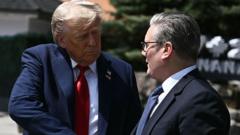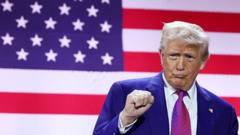**As the world's two largest economies step back from a prolonged trade war, this truce reshapes the landscape of global commerce while prompting speculation on future relations.**
**US-China Tariff Truce: A New Chapter in Trade Relations**

**US-China Tariff Truce: A New Chapter in Trade Relations**
**The recent tariff reduction agreement marks a significant thaw in US-China trade tensions, hinting at potential future collaborations.**
The US and China have entered into a notable agreement aimed at reducing the import tariffs that have historically characterized their trade relationship. This decision comes as a substantial easing of the trade war that has reverberated globally, affecting economies worldwide, including the UK.
So, what does this recent announcement entail? Both nations have confirmed the cancellation or suspension of various tariffs imposed on each other in the wake of heightened tensions initiated by former President Donald Trump. Specifically, the deal includes a reduction of US tariffs on Chinese goods from an imposing 145% to a more manageable 30%, while China has agreed to lower tariffs on select US imports from 125% to 10%. Additionally, China has halted critical mineral exports to the US, which were previously restricted as a retaliatory measure. However, the agreement does retain a 20% tariff component aimed explicitly at pressuring Beijing regarding its stance on the illegal trade of fentanyl, a potent opioid.
The announcement follows negotiations held in Switzerland, marking the first dialogue between the two countries since the trade war intensified earlier this year. What remains uncertain is the course of action after the agreed-upon 90 days. Speculation regarding the continuation of trade discussions suggests a willingness to avoid a complete economic separation, with both Treasury Secretary Scott Bessent and representatives from China's commerce ministry expressing optimism for future agreements to deepen bilateral cooperation.
The trade of goods between the US and China is significant. In 2024, the primary goods traded included US agricultural products such as soybeans and pharmaceuticals sent to China, in exchange for large quantities of electronics and toys. The largest share of US imports from China comprises smartphones, representing 9% of total imports, heavily driven by Apple’s production in China. Overall, the US significantly purchases more from China, estimated at $440 billion compared to the $145 billion it exports, an imbalance that had long been critiqued by the Trump administration.
The recent truce has bolstered investor confidence as they anticipate a rebound in the shipping sector following months of diminished trade volumes triggered by rising tariffs. However, it raises questions of who truly stands to benefit. Politicians on both sides are already claiming victories in this truce. Analysts suggest that this hints at a negotiation reset for both parties — while the US might present this as a successful strategy for attaining better trade conditions, China finds itself in a potentially stronger negotiating position moving forward.
Economists from Deutsche Bank have indicated that these tariff reductions set potential boundaries for future American trade tariffs, creating a possible "cap and floor." Thus, the implications of this truce extend further than bilateral relations, potentially reshaping the framework of international trade in a post-tariff environment.
So, what does this recent announcement entail? Both nations have confirmed the cancellation or suspension of various tariffs imposed on each other in the wake of heightened tensions initiated by former President Donald Trump. Specifically, the deal includes a reduction of US tariffs on Chinese goods from an imposing 145% to a more manageable 30%, while China has agreed to lower tariffs on select US imports from 125% to 10%. Additionally, China has halted critical mineral exports to the US, which were previously restricted as a retaliatory measure. However, the agreement does retain a 20% tariff component aimed explicitly at pressuring Beijing regarding its stance on the illegal trade of fentanyl, a potent opioid.
The announcement follows negotiations held in Switzerland, marking the first dialogue between the two countries since the trade war intensified earlier this year. What remains uncertain is the course of action after the agreed-upon 90 days. Speculation regarding the continuation of trade discussions suggests a willingness to avoid a complete economic separation, with both Treasury Secretary Scott Bessent and representatives from China's commerce ministry expressing optimism for future agreements to deepen bilateral cooperation.
The trade of goods between the US and China is significant. In 2024, the primary goods traded included US agricultural products such as soybeans and pharmaceuticals sent to China, in exchange for large quantities of electronics and toys. The largest share of US imports from China comprises smartphones, representing 9% of total imports, heavily driven by Apple’s production in China. Overall, the US significantly purchases more from China, estimated at $440 billion compared to the $145 billion it exports, an imbalance that had long been critiqued by the Trump administration.
The recent truce has bolstered investor confidence as they anticipate a rebound in the shipping sector following months of diminished trade volumes triggered by rising tariffs. However, it raises questions of who truly stands to benefit. Politicians on both sides are already claiming victories in this truce. Analysts suggest that this hints at a negotiation reset for both parties — while the US might present this as a successful strategy for attaining better trade conditions, China finds itself in a potentially stronger negotiating position moving forward.
Economists from Deutsche Bank have indicated that these tariff reductions set potential boundaries for future American trade tariffs, creating a possible "cap and floor." Thus, the implications of this truce extend further than bilateral relations, potentially reshaping the framework of international trade in a post-tariff environment.






















